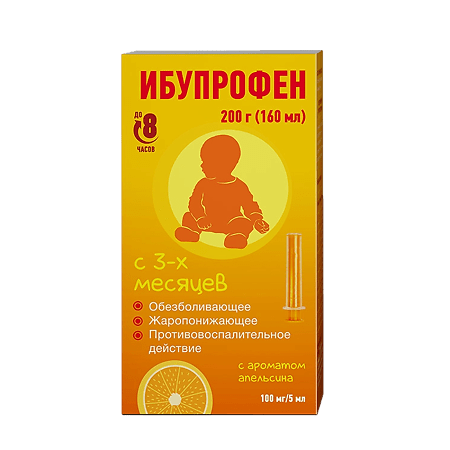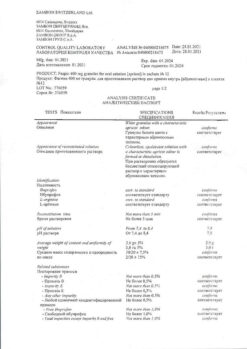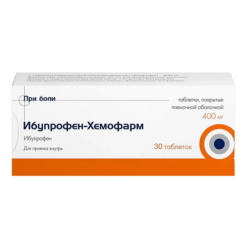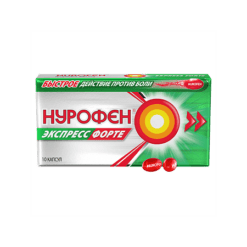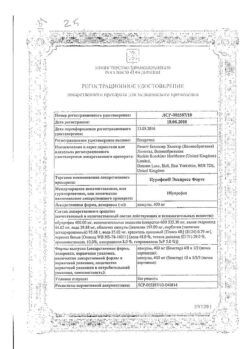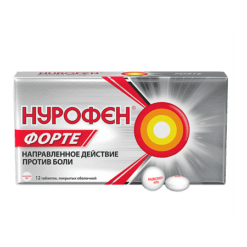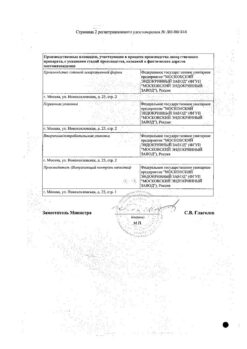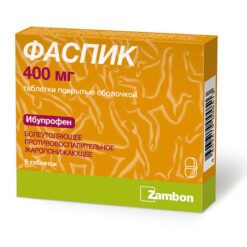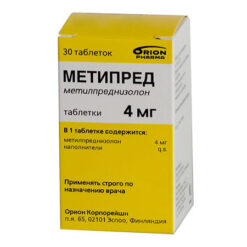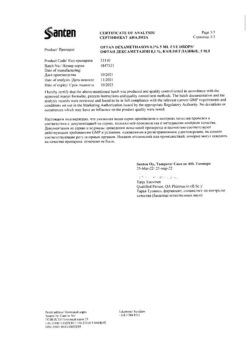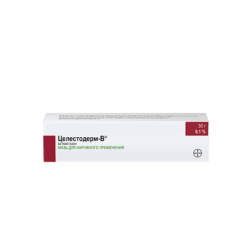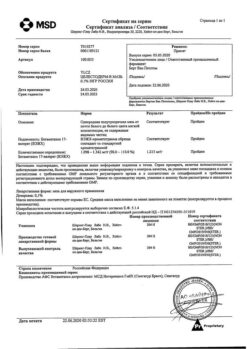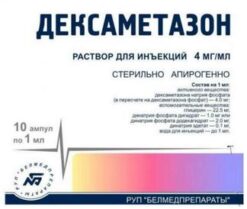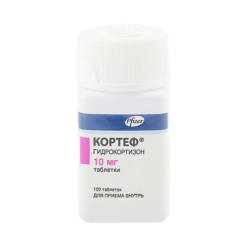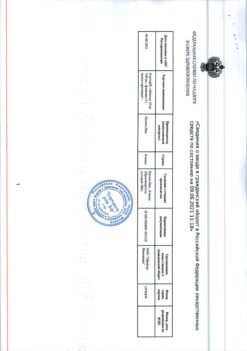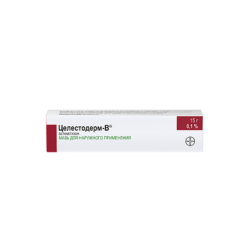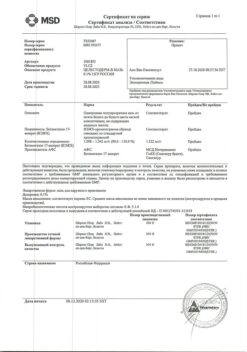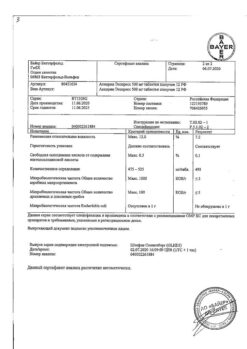No products in the cart.
Ibuprofen, 100 mg/5 ml orange 200 g suspension
€5.00 €4.97
Out of stock
(E-mail when Stock is available)
Description
Pharmacotherapeutic group: Non-steroidal anti-inflammatory drug (NSAID)
ATC code: M01AE01
Pharmacodynamics:
The mechanism of action of ibuprofen propionic acid derivative from the group of non-steroidal anti-inflammatory drugs (NSAIDs) is due to the inhibition of the synthesis of prostaglandins – mediators of pain inflammation and hyperthermia. Indiscriminately blocks cyclooxygenase 1 (COX-1) and cyclooxygenase 2 (COX-2), and thus inhibits the synthesis of prostaglandins. In addition ibuprofen reversibly inhibits platelet aggregation. It has analgesic, antipyretic and anti-inflammatory effects. The analgesic effect is most pronounced for pain of an inflammatory nature. The action of the drug lasts up to 8 hours.
Pharmacokinetics:
Absorption – fast and almost completely absorbed from the gastrointestinal tract (gastrointestinal tract) (binding to blood plasma proteins – 90%). After taking the drug on an empty stomach in adults ibuprofen is detected in blood plasma after 15 minutes the maximum concentration (Cmax) of ibuprofen in blood plasma is reached after 60 minutes. Taking the drug with food can increase the time to reach maximum concentration (TCmax) up to 1-2 hours. The half-life (T1/2) is 2 hours. Slowly penetrates into the joint cavity and stays in synovial fluid producing higher concentrations in synovial fluid than in blood plasma. After absorption, about 60% of the pharmacologically inactive R-form is slowly transformed into the active S-form. It is metabolized in the liver. It is excreted by kidneys (not more than 1% unchanged) and to a lesser extent with bile.
In limited studies ibuprofen was found in very low concentrations in breast milk.
Indications
Indications
Ibuprofen suspension for children is used in children from 3 months to 12 years of age for symptomatic treatment as an antipyretic for acute respiratory diseases (including influenza), childhood infections, other infectious and inflammatory diseases and post-vaccination reactions accompanied by an increase in body temperature.
The drug is used as a symptomatic analgesic for pain of mild or moderate intensity, including: toothache, headache, migraine, neuralgia, ear pain, sore throat, sprain pain, muscle pain, rheumatic pain, joint pain.
The drug is intended for symptomatic therapy to reduce pain and inflammation at the time of use and does not affect the progression of the disease.
Pharmacological effect
Pharmacological effect
Pharmacotherapeutic group: Non-steroidal anti-inflammatory drug (NSAID)
ATX code: M01AE01
Pharmacodynamics:
The mechanism of action of ibuprofen, a derivative of propionic acid from the group of non-steroidal anti-inflammatory drugs (NSAIDs), is due to inhibition of the synthesis of prostaglandins – mediators of pain, inflammation and hyperthermic reaction. Indiscriminately blocks cyclooxygenase 1 (COX-1) and cyclooxygenase 2 (COX-2), as a result of which it inhibits the synthesis of prostaglandins. In addition, ibuprofen reversibly inhibits platelet aggregation. It has an analgesic, antipyretic and anti-inflammatory effect. The analgesic effect is most pronounced for inflammatory pain. The effect of the drug lasts up to 8 hours.
Pharmacokinetics:
Absorption – high, quickly and almost completely absorbed from the gastrointestinal tract (GIT) (binding with blood plasma proteins – 90%). After taking the drug on an empty stomach in adults, ibuprofen is detected in the blood plasma after 15 minutes; the maximum concentration (Cmax) of ibuprofen in the blood plasma is reached after 60 minutes. Taking the drug with food may increase the time to reach maximum concentration (TCmax) by up to 1-2 hours. The half-life (T1/2) is 2 hours. Slowly penetrates into the joint cavity and lingers in the synovial fluid, creating higher concentrations in it than in the blood plasma. After absorption, about 60% of the pharmacologically inactive R-form is slowly transformed into the active S-form. Metabolized in the liver. Excreted by the kidneys (no more than 1% unchanged) and to a lesser extent with bile.
In limited studies, ibuprofen has been found in breast milk at very low concentrations.
Special instructions
Special instructions
Please read this leaflet carefully before you start using this medication as it contains important information for you.
Save the instructions as you may need them again.
If you have any questions, consult your doctor.
The medicine you are being treated with is intended for you personally and should not be shared with others as it may cause harm to them even if they have the same symptoms as you.
It is recommended to take the drug in the shortest possible course and in the minimum effective dose necessary to eliminate symptoms.
During long-term treatment, monitoring of the peripheral blood picture and the functional state of the liver and kidneys is necessary. When symptoms of gastropathy appear, careful monitoring is indicated, including esophagogastroduodenoscopy, a complete blood count (hemoglobin determination), and a stool test for occult blood. If it is necessary to determine 17-ketosteroids, the drug should be discontinued 48 hours before the study. During the treatment period, ethanol intake is not recommended. The drug is contraindicated in patients with fructose intolerance as it contains maltitol.
Ibuprofen can be used in children with diabetes since the drug does not contain sugar. Does not contain dyes.
Patients with renal failure should consult a doctor before using the drug as there is a risk of deterioration in the functional state of the kidneys.
Patients with a history of hypertension and/or chronic heart failure should consult a doctor before using the drug since the drug may cause fluid retention, increased blood pressure and edema.
The use of NSAIDs in patients with chickenpox may be associated with an increased risk of developing severe purulent complications of infectious and inflammatory diseases of the skin and subcutaneous fat (for example, necrotizing fasciitis). In this regard, it is recommended to avoid using the drug for chickenpox.
Impact on the ability to drive vehicles. Wed and fur.:
Patients who experience dizziness, drowsiness, lethargy, or blurred vision while taking ibuprofen should avoid driving or operating machinery.
Active ingredient
Active ingredient
Ibuprofen
Composition
Composition
Composition per 5 ml suspension
Active ingredient: ibuprofen – 100.00 mg.
Excipients:
maltitol syrup – 2111.25 mg;
glycerol – 600.00 mg;
xanthan gum – 35.00 mg;
sodium citrate – 25.45 mg;
citric acid monohydrate – 20.00 mg;
orange flavor – 12.50 mg;
sodium saccharinate – 10.00 mg;
sodium chloride – 5.50 mg;
domiphen bromide – 0.50 mg;
polysorbate 80 – 0.50 mg;
purified water to 5.0 ml.
Pregnancy
Pregnancy
The use of the drug is contraindicated in the third trimester of pregnancy. Before using the drug in the first and second trimesters of pregnancy or during breastfeeding, you should consult your doctor.
There is evidence that ibuprofen can pass into breast milk in small quantities without any adverse effects on the health of the infant.
Before using the drug, if you are pregnant or think you might be pregnant or are planning a pregnancy, you should consult your doctor.
Contraindications
Contraindications
– Hypersensitivity to ibuprofen or any of the components included in the drug.
– Complete or incomplete combination of bronchial asthma, recurrent polyposis of the nose and paranasal sinuses and intolerance to acetylsalicylic acid or other NSAIDs.
– A history of bleeding or perforation of a gastrointestinal ulcer caused by the use of NSAIDs.
– Erosive and ulcerative diseases of the gastrointestinal tract (including peptic ulcer of the stomach and duodenum, Crohn’s disease, ulcerative colitis) or ulcerative bleeding in the active phase or in history (two or more confirmed episodes of peptic ulcer or ulcerative bleeding).
– Severe liver failure or active liver disease.
– Severe renal failure (creatinine clearance <30 ml/min) confirmed hyperkalemia.
– Decompensated heart failure period after coronary artery bypass surgery.
– Cerebrovascular or other bleeding.
– Hemophilia and other bleeding disorders (including hypocoagulation) hemorrhagic diathesis.
– Pregnancy (III trimester).
– Fructose intolerance.
– Child’s body weight is up to 5 kg.
If you have one or more of the diseases and conditions listed above, you should consult your doctor before starting use.
With caution:
If you have the conditions listed in this section, you should consult your doctor before using the drug.
Concomitant use of other NSAIDs, a history of a single episode of gastric ulcer or ulcerative bleeding of the gastrointestinal tract, gastritis, enteritis, colitis, the presence of Helicobacter pylori infection, ulcerative colitis; bronchial asthma or allergic diseases in the acute stage or in history – bronchospasm may develop; severe somatic diseases: systemic lupus erythematosus or mixed connective tissue disease (Sharpe’s syndrome) – increased risk of aseptic meningitis; chicken pox; renal failure, including with dehydration (creatinine clearance 30-60 ml/min), fluid retention and edema, liver failure, arterial hypertension and/or heart failure, cerebrovascular diseases, dyslipidemia/hyperlipidemia, diabetes mellitus, peripheral arterial diseases, blood diseases of unknown etiology (leukopenia, anemia); simultaneous use of other medications that may increase the risk of ulcers or bleeding, in particular oral glucocorticosteroids (including prednisone), anticoagulants (including warfarin), selective serotonin reuptake inhibitors (including citalopram fluoxetine paroxetine sertraline) or antiplatelet agents (including acetylsalicylic acid clopidogrel); pregnancy (I-II trimester) period of breastfeeding old age.
If you have one or more of the diseases and conditions listed above, you should consult your doctor before starting use.
Side Effects
Side Effects
The risk of side effects can be minimized if you take the drug for a short course in the minimum effective dose necessary to eliminate symptoms.
Side effects are predominantly dose-dependent. The following adverse reactions were observed with short-term use of ibuprofen in doses not exceeding 1200 mg/day. When treating chronic conditions and with long-term use, other adverse reactions may occur.
The incidence of adverse reactions was assessed based on the following criteria: very common (≥ 1/10) common (from ≥ 1/100 to < 1/10) uncommon (from ≥ 1/1000 to < 1/100) rare (from ≥ 1/10,000 to < 1/1000) very rare (< 1/10) 000) frequency unknown (no frequency estimates available).
From the blood and lymphatic system:
– Very rare: hematopoietic disorders (anemia, leukopenia, aplastic anemia, hemolytic anemia, thrombocytopenia, pancytopenia, agranulocytosis). The first symptoms of such disorders are fever, sore throat, superficial oral ulcers, flu-like symptoms, severe weakness, nosebleeds and subcutaneous hemorrhages, bleeding and bruising of unknown etiology.
From the immune system:
– Uncommon: hypersensitivity reactions – nonspecific allergic reactions and anaphylactic reactions reactions from the respiratory tract (bronchial asthma including its exacerbation bronchospasm shortness of breath dyspnea) skin reactions (itching urticaria purpura Quincke’s edema exfoliative and bullous dermatoses including toxic epidermal necrolysis Lyell’s syndrome Stevens-Johnson syndrome multiforme erythema) allergic rhinitis eosinophilia.
– Very rare: severe hypersensitivity reactions including swelling of the face of the tongue and larynx, shortness of breath, tachycardia, arterial hypotension (anaphylaxis, angioedema or severe anaphylactic shock).
From the nervous system:
– Uncommon: headache.
– Very rare: aseptic meningitis (in patients with autoimmune diseases).
From the side of the heart6
– Frequency unknown: heart failure, peripheral edema, long-term use increases the risk of thrombotic complications (for example, myocardial infarction, stroke).
From the side of blood vessels:
– Frequency unknown: increased blood pressure.
From the respiratory system of the chest and mediastinum
– Frequency unknown: bronchial asthma, bronchospasm, shortness of breath.
From the gastrointestinal tract:
– Uncommon: abdominal pain, nausea, dyspepsia.
– Rare: diarrhea flatulence constipation vomiting.
– Very rare: peptic ulcer, perforation or gastrointestinal bleeding, melena, hematemesis, ulcerative stomatitis, gastritis.
– Frequency unknown: exacerbation of ulcerative colitis and Crohn’s disease.
From the liver and biliary tract:
– Very rare: liver dysfunction.
From the kidneys and urinary tract:
– Very rare: acute renal failure (compensated and decompensated), especially with long-term use in combination with an increase in the concentration of urea in the blood plasma and the appearance of edema, papillary necrosis.
Others
– Very rare: edema, including peripheral.
Laboratory and instrumental data:
– hematocrit or hemoglobin (may decrease)
– bleeding time (may increase)
– plasma glucose concentration (may decrease)
– creatinine clearance (may decrease)
– plasma creatinine concentration (may increase)
– activity of “liver” transaminases (may increase)
If side effects occur, you should stop taking the drug and consult a doctor.
If any of the side effects indicated in the instructions get worse or you notice any other side effects not listed in the instructions, tell your doctor.
Interaction
Interaction
The simultaneous use of ibuprofen with the following drugs should be avoided:
– Acetylsalicylic acid: with the exception of low doses of acetylsalicylic acid (no more than 75 mg per day) prescribed by a doctor, since combined use may increase the risk of side effects. With simultaneous use, ibuprofen reduces the anti-inflammatory and antiplatelet effect of acetylsalicylic acid (it is possible to increase the incidence of acute coronary insufficiency in patients receiving small doses of acetylsalicylic acid as an antiplatelet agent after starting ibuprofen).
– Other NSAIDs, including selective COX-2 inhibitors: simultaneous use of two or more drugs from the NSAID group should be avoided due to a possible increased risk of side effects.
Use with caution simultaneously with the following medications:
– Anticoagulants and thrombolytic drugs: NSAIDs may enhance the effect of anticoagulants, in particular warfarin and thrombolytic drugs.
– Antihypertensives (ACE inhibitors and angiotensin II antagonists) and diuretics: NSAIDs may reduce the effectiveness of drugs in these groups. Diuretics and ACE inhibitors may increase the nephrotoxicity of NSAIDs.
– Glucocorticosteroids: increased risk of gastrointestinal ulcers and gastrointestinal bleeding.
– Antiplatelet agents and selective serotonin reuptake inhibitors: increased risk of gastrointestinal bleeding.
– Cardiac glycosides: simultaneous administration of NSAIDs and cardiac glycosides can lead to worsening heart failure, a decrease in glomerular filtration rate and an increase in the concentration of cardiac glycosides in the blood plasma.
– Lithium preparations: there is evidence of the likelihood of an increase in the concentration of lithium in the blood plasma during the use of NSAIDs.
– Methotrexate: there is evidence of the likelihood of an increase in the concentration of methotrexate in the blood plasma during the use of NSAIDs.
– Cyclosporine: increased risk of nephrotoxicity with simultaneous administration of NSAIDs and cyclosporine.
– Mifepristone: NSAIDs should be started no earlier than 8-12 days after taking mifepristone as NSAIDs may reduce the effectiveness of mifepristone.
– Tacrolimus: When NSAIDs and tacrolimus are co-administered, the risk of nephrotoxicity may increase.
– Zidovudine: Concomitant use of NSAIDs and zidovudine may lead to increased hematotoxicity. There is evidence of an increased risk of hemarthrosis and hematomas in HIV-positive patients with hemophilia who were co-treated with zidovudine and ibuprofen.
– Quinolone antibiotics: in patients receiving concomitant treatment with NSAIDs and quinolone antibiotics, the risk of seizures may increase.
If you are using the medications listed above or other medications (including over-the-counter medications), consult your doctor before using the drug.
Overdose
Overdose
In children, overdose symptoms may occur after taking a dose exceeding 400 mg/kg body weight. In adults, the dose-dependent effect of overdose is less pronounced. The half-life of the drug in case of overdose is 15-3 hours.
Symptoms: nausea, vomiting, epigastric pain or less commonly, diarrhea, tinnitus, headache and gastrointestinal bleeding.
In more severe cases, manifestations from the central nervous system are observed: drowsiness, rarely – agitation, convulsions, disorientation, coma.
In cases of severe poisoning, metabolic acidosis and increased prothrombin time, renal failure, liver tissue damage, decreased blood pressure, respiratory depression and cyanosis may develop.
In patients with bronchial asthma, exacerbation of this disease is possible.
Treatment: symptomatic with mandatory maintenance of airway patency, ECG monitoring and vital signs until the patient’s condition normalizes. Oral use of activated charcoal or gastric lavage is recommended within 1 hour after taking a potentially toxic dose of ibuprofen.
If ibuprofen has already been absorbed, an alkaline drink can be prescribed in order to remove the acidic derivative of ibuprofen by the kidneys through forced diuresis.
Frequent or prolonged seizures should be treated with intravenous diazepam or lorazepam.
If bronchial asthma worsens, the use of bronchodilators is recommended.
If symptoms of overdose appear, stop taking the drug and consult a doctor immediately.
Storage conditions
Storage conditions
At a temperature not exceeding 25 °C.
Keep out of the reach of children.
Shelf life
Shelf life
2 years.
Use within 6 months after opening the bottle.
Do not use a drug that has expired.
Manufacturer
Manufacturer
Pharmstandard-Leksredstva, Russia
Additional information
| Shelf life | 2 years. Between 6 months after opening the bottle, do not use. Do not use if the product has expired. |
|---|---|
| Conditions of storage | At a temperature not exceeding 25 ° C. Store out of reach of children. |
| Manufacturer | Pharmstandard-Leksredstva, Russia |
| Medication form | oral suspension |
| Brand | Pharmstandard-Leksredstva |
Other forms…
Related products
Buy Ibuprofen, 100 mg/5 ml orange 200 g suspension with delivery to USA, UK, Europe and over 120 other countries.

